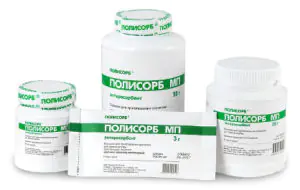Poisoning with Azaleptin, an antipsychotic with a pronounced sedative effect, can have very serious consequences. The drug is prescribed to patients suffering from cognitive impairment, schizophrenia, depression, various manias and other mental disorders.
Episodes of Azaleptin overdose occur quite often, but provided timely medical care is provided, the patient's condition quickly returns to normal. However, in some especially severe cases, the prognosis of poisoning can be extremely unfavorable for the victim, even death.
The content of the articleBasic information about the drug
Azaleptin is the trade (proprietary) name for the drug Clozapine. The drug belongs to the group of antipsychotics (neuroleptics). Available in the form of tablets of 25 and 100 mg for oral administration. The permissible single dose of Azaleptin is no more than 300 mg, the daily dose is no more than 400 mg. In each individual case, the dosage is selected individually. Starting from a minimum, it gradually increases until the desired clinical effect is achieved. After this, the patient is transferred to maintenance therapy with small doses of Azaleptin.
Self-prescribing and taking the drug is strictly prohibited to avoid Azaleptin poisoning.
Pharmacological action of the drug
The active substance - clozapine - has a pronounced sedative (calming) effect due to blocking receptors in the brain that are sensitive to dopamine (a neurotransmitter, the “hormone of joy and pleasure”). Therefore, most patients are mistaken in considering Azaleptin a hypnotic. The sedative effect in this case can be regarded as a side effect.
The main effect of the drug is to reduce the level of aggressiveness and psychomotor agitation, eliminate delusions and hallucinations in patients with severe mental disorders. In addition, the product has antiemetic, anticonvulsant and hypothermic properties.
The drug, when taken simultaneously with antihypertensives, analgesics or hypnotics, enhances their effect, although, unlike the latter, it does not give a “submelancholic tint” and a feeling of “heaviness in the head” the morning after taking the pill.
Alcohol and Azaleptin are incompatible substances: the medicine increases the toxic effect of ethanol on the body many times over. Remember this!
Pharmacodynamics
After oral administration, Azaleptin is rapidly absorbed from the gastrointestinal tract, reaches its maximum concentration in the blood plasma after 1-6 hours (on average 2.5 hours), accumulates in the liver, kidneys and lungs. Substances (metabolites) formed as a result of the breakdown of clozapine are excreted from the body with urine and bile within 8 hours with a single use and 12 hours with a course of use of the drug.
Indications for use of Azaleptin
The drug is prescribed as part of complex therapy for people with unstable mental health to relieve aggressiveness, agitation, hyperactivity, and insomnia.
Azaleptin also shows good results in the treatment of cognitive disorders:
- impaired memory and concentration;
- decreased mental performance and perception of information;
- deterioration in the ability to think logically and make decisions.
In psychiatric practice, Azaleptin is used to treat acute and chronic pathologies:

- schizophrenia (especially forms resistant to therapy with other antipsychotics);
- manic-depressive states;
- hallucinosis of various etiologies;
- bipolar mental disorders;
- psychotic disorders in children over 5 years of age.
Prescribing Azaleptin as a sleeping pill is advisable only in cases where sleep disturbances and insomnia are chronic and significantly reduce the patient’s quality of life.
Contraindications to the drug
In most cases, the drug is well tolerated by patients and does not cause serious side effects.
However, there are a number of conditions in which the use of Azaleptin is prohibited:
- individual intolerance to clozapine;
- blood diseases characterized by a pathological decrease in granulocytes (granulocytopenia, agranulocytosis). The restriction does not apply to cancer patients in whom this abnormality in the blood composition is a consequence of chemotherapy;
- violation of the hematopoietic function of the bone marrow;
- alcoholic psychosis (acute form), drug intoxication, coma;
- renal/liver failure (acute or chronic);
- BPH;
- epilepsy;
- glaucoma;
- pregnancy;
- breastfeeding period;
- children under 5 years of age.
Causes and symptoms of Azaleptin poisoning
The cause of poisoning with any drug is always an overdose (accidental or deliberate). Azaleptin is no exception. Let us remind you that no more than 300 mg of the drug is allowed for a single dose, and no more than 400 mg per day. The lethal dose of Azaleptin is supposed to be 3 g.
Clinical picture of overdose
Exceeding the permissible single dose leads to the development of symptoms of Azaleptin poisoning:
- depression of consciousness of varying severity (stunning, stupor, coma);
- increased anxiety, excitability;
- delirium (delusional state with hallucinations);
- grand mal epileptic seizures;
- instability of body temperature with a tendency to decrease;
- increased heart rate (tachycardia);
- heart rhythm disturbance (arrhythmia);
- decreased blood pressure (hypotension);
- weakness, sweating, cold sweat;
- pale and cold skin;
- nausea and vomiting;
- stomach ache;
- respiratory depression;
- atony (loss of tone, relaxation) of the intestines;
- collapse (a sharp drop in blood pressure that threatens life);
- death.
First aid for an overdose of Azaleptin
The further condition and, possibly, the life of the patient depends on the speed of first aid. Therefore, you need to act quickly, strictly following the following algorithm:
- Call the ambulance team.
- Rinse the victim's stomach and artificially induce vomiting. To do this, you need to drink some water and press your finger on the root of the tongue. After emptying the stomach, repeat the procedure several times (recommended until the rinsing water is clean).
- Give the patient to take any enterosorbent:
- activated carbon;
- Filtrum-STI;
- Polysorb;

- Polyphepan;
- ;
- ;
- Bifiform;
- ;
- ;
- Neosmectin, etc.
- Place the victim in bed, provide access to fresh air and plenty of fluids.
- Monitor indicators of the cardiovascular system (pressure, pulse), body temperature and breathing of the patient.
After the measures taken, specialists prescribe symptomatic treatment and monitor the patient for several days.
Treatment of poisoning
Therapy consists of eliminating the pathological symptoms present in the victim:
- pain in the stomach - painkillers and antispasmodics: No-shpa, Drotaverine, Papaverine, Spazgan, Revalgin, Spazmalgon, Novigan, etc.;
- nausea and vomiting - Cerucal, Motilium, Zofran;
- heartburn - Almagel, Rennie, Phosphalugel, Gastal, Gaviscon;
- excessive excitement, muscle cramps - extract of valerian, motherwort (in tablets!), other sedatives.
The state of the cardiovascular system is monitored using an ECG. Restoring the water-salt balance is ensured by drinking plenty of water.
It is necessary to monitor the patient’s health for a week in order to early identify possible complications of an overdose of Azaleptin.
Consequences
Even if the victim feels better after first aid, consultation with specialists cannot be refused. Only a doctor can determine the severity of poisoning and assess the risk of developing any complications.
Possible consequences include:
- drowsiness for a long time;
- difficulty breathing, feeling of lack of air;
- decrease in body temperature and blood pressure;
- visual and hearing impairment;
- impaired hematopoiesis (decreased granulocyte concentration);
- myasthenia gravis (quick muscle fatigue);
- muscle cramps;
- tremor of fingers, etc.
After some time (each person has an individual recovery period), the unpleasant symptoms will gradually disappear without a trace. But this is provided that the patient strictly follows all the doctor’s recommendations, takes the necessary medications and undergoes regular examinations.
Prevention of poisoning with Azaleptin
Azaleptin is a potent antipsychotic that cannot be purchased in a pharmacy without a doctor’s prescription. Therefore, you need to carefully read the instructions before taking the medicine and strictly follow the doctor’s recommendations regarding the dosage of the drug. You should not combine the use of Azaleptin with other antipsychotic and hypnotic drugs.
An overdose of Azaleptin can be either deliberate (suicide attempt) or accidental. In the latter case, the risk group includes elderly people, children and adolescents, as well as persons suffering from pathologies:
- kidneys and liver;
- heart and blood vessels;
- bone marrow;
- endocrine system (diabetes mellitus);
In addition, people dependent on alcohol, as well as people with various mental and behavioral disorders, need to handle the drug with extreme caution.
Azaleptin should be stored out of the reach of children and persons belonging to the categories listed above.



